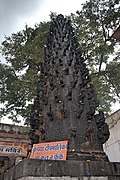
Bhairava is a Shaivite deity worshiped by Hindus. In Shaivism, he is a fierce manifestation of Shiva associated with annihilation. In Trika system Bhairava represents Supreme Reality, synonymous to Para Brahman. Generally in Hinduism, Bhairava is also called Dandapani and Swaswa meaning "whose vehicle is a dog". In Vajrayana Buddhism, he is considered a fierce emanation of boddhisatva Mañjuśrī and also called Heruka, Vajrabhairava and Yamantaka.

Maha Shivaratri is a Hindu festival celebrated annually in honour of the god Shiva. The name also refers to the night when Shiva performs the heavenly dance. There is a Shivaratri in every luni-solar month of the Hindu calendar, on the month's 13th night/14th day, but once a year in late winter and before the arrival of Summer, marks Maha Shivaratri which means "the Great Night of Shiva".

Alandi is a town and a municipal council in the Pune district in the state of Maharashtra, India. The town is popular as a place of pilgrimage and the resting place of the 13th century Marathi saint Dnyaneshwar.

Mahakaleshwar Jyotirlinga is a Hindu temple dedicated to Lord Shiva and is one of the twelve Jyotirlingams, shrines which are said to be the most sacred abodes of Lord Shiva. It is located in the ancient city of Ujjain in the state of Madhya Pradesh, India. The temple is situated on the side of the holy river KShipra. The presiding deity, Lord Shiva in the lingam form is believed to be Swayambhu, deriving currents of power (Shakti) from within itself as against the other images and lingams that are ritually established and invested with mantra-shakti.
Ujjain is an ancient city of central India, in the Malwa region of the Indian state of Madhya Pradesh, on the eastern bank of the Kshipra River.
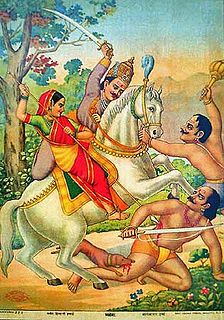
Khandoba, Martanda Bhairava,Malhari, or Malhar is a Hindu deity worshiped as a manifestation of Shiva mainly in the Deccan plateau of India, especially in the state of Maharashtra. He is the most popular Kuladaivat in Maharashtra. He is also the patron deity of select warrior, farming castes, Dhangar community and Brahmin (priestly) castes as well as several of the hunter/gatherer tribes that are native to the hills and forests of this region. The cult of Khandoba has linkages with Hindu and Jain traditions, and also assimilates all communities irrespective of caste, including Muslims. The worship of Khandoba developed during the 9th and 10th centuries from a folk deity into a composite god possessing the attributes of Shiva, Bhairava, Surya and Kartikeya (Skanda). He is depicted either in the form of a linga, or as an image of a warrior riding on a bull or a horse. The foremost centre of Khandoba worship is Jejuri in Maharashtra. The legends of Khandoba, found in the text Malhari Mahatmya and also narrated in folk songs, revolve around his victory over demons Mani-malla and his marriages.
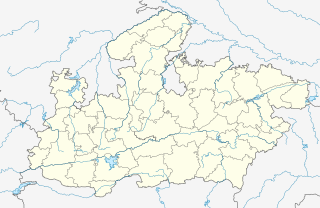
Agar is a town with a municipal government in the state of Madhya Pradesh, India. It is the administrative headquarters for the Agar Malwa District which was formed in 2013 from a part of Shajapur District. The town is situated along the ujjain—Kota SH-27 highway.

Tuljabhavani Temple is a Hindu temple dedicated to the goddess Bhavani(Parvati aspect of Durga).It is located in Tuljapur in Osmanabad district of Maharashtra and is considered as one of the 51 Shakti Pithas. It is situated 45 km from Solapur.The temple was built in c. 12th century CE. Bhavani is an avatar of the Hindu goddess Parvati.
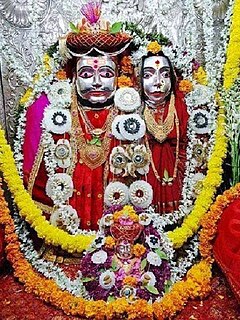
Shreenath Mhaskoba is Kaal bhairava an Avatar of the Hindu deity Shiva. The clan deity of many Hindus, the worship of Kaala Bhairava as Shreenath Mhaskoba was popularized by the caste. He is also worshipped by tribal and pastoral people at, Mhaswad, [Borban] and [Sonari].

Suryanar Kovil is a Hindu temple dedicated to the deity Hindu Sun-God, located in Suryanar Kovil, a village near the South Indian town of Kumbakonam Thanjavur District in Tamil Nadu, India. The presiding deity is Suriyanar, the Sun and his consorts Ushadevi and Pratyusha Devi. The temple also has separate shrines for the other eight planetary deities. The temple is considered one of the nine Navagraha temples in Tamil Nadu. The temple is one of the few historic temples dedicated to Sun god and is also the only temple in Tamil Nadu which has shrines for all the planetary deities.
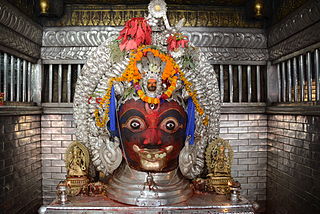
Akash Bhairav is one of the different forms of Bhairava. He is known as King Yalambar in History of Nepal, as Barbarika in Mahabharata and Āaju meaning First King in NepalBhasa.
Sonana Khetlaji is a temple of God Khetlaji located in the village Sonana of Desuri tehsil of Pali district in Indian state of Rajasthan.
The Shivnetras are an almost extinct community which originated from Varanasi in Northern India. Similar to the Kshatriyas but somewhat more controversial in social context, the Shivnetras are almost extinct today due to the widespread relocation and displacement of the community.
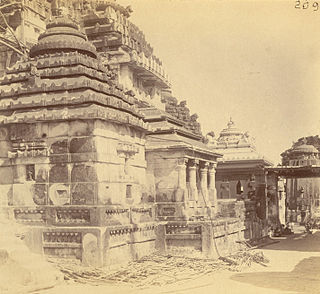
The Vimala Temple or Bimala Temple is a Hindu temple dedicated to goddess Vimala (Bimala), located within the Jagannath Temple complex in Puri in the Indian state of Odisha. It is generally regarded as a Shakti Pitha, among the holiest temples dedicated to the Hindu Goddess.

Om Banna is a shrine located in Pali district near Jodhpur, India, devoted to a deity in the form of a motorcycle. It is located 20 kilometres (12 mi) from Pali and 53 kilometres (33 mi) away from Jodphur on the Pali-Jodhpur highway, near Chotila village. The motorcycle is a 350cc Royal Enfield Bullet RNJ 7773.

Bhairava Ashtami, also known as Bhairavashtami, Bhairava Jayanti, Kala-Bhairava Ashtami and Kala-Bhairava Jayanti is a Hindu holy day commemorating the birthday of Bhairava, a fearsome and wrathful manifestation of the god Shiva. It falls on the eighth lunar day (ashtami) in the fortnight of the waning moon in the Hindu month of Kartik or Margashirsha. By both schemes, Bhairava Ashtami falls on the same day in November–December-January. The name Kalashtami is sometimes used to refer to this day, but might also refer to any ashtami in Krishna paksha, all of which are sacred days of Bhairava, who is also called also Dandapani and he rides a dog he is also known as Swaswa meaning "whose horse is a dog".

Kaal Bhairav Mandir is one of the oldest Shiva temples in Varanasi, India. Situated in Bharonath, Vishweshwarganj (Varanasi), this temple has great historical and cultural importance in Hinduism; especially amongst the locals. The temple is dedicated to Bhairava, a fierce form of Shiva and wears a garland of skulls and carries a club of peacock feathers. The word "Kaal" means both "death" and "fate". It is believed that even death is afraid of Kaal Bhairav.
Kaal Bhairav Mandir may refer to any temple dedicated to the Hindu deity Kaal Bhairav, including:
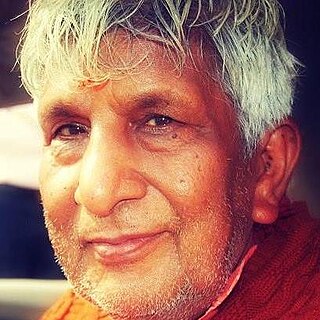
Govind Prasad Kukreti, popularly known as Dabral Baba, was an Indian yogi and a disciple of Vikrant Bhairav and Mahavatar Babaji. He was also known as Baba and Shri Dabral Baba.



